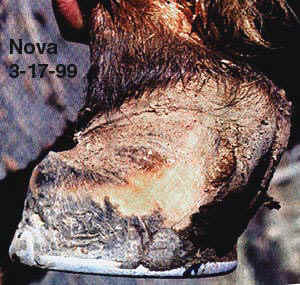
Treating Founder (Chronic Laminitis) without Horseshoes, Section 4
(Version with full-sized photos)
NOVA'S STORY
illustrates how a severely foundered horse responded better to knowledgeable barefoot trims than shoeing and vet services costing thousands of dollars. A smallish young woman in Canada, armed only with a hoof knife, nippers and rasp, but trained by Dr. Strasser, outperformed all the high tech vets and blacksmiths who had failed to help Nova. Truly a victory of the underdog!
Denise McLain's horse, Nova, a 19-year-old Morgan gelding, is an example of how a barefoot approach can out-perform shoes in the case of a severely foundered horse. It also illustrates how much damage to the coffin bone can result from high-heeled orthopedic shoeing over time.
Case History:
In November of '94, Nova had colic surgery at Ohio State that involved removing 8 feet of intestine. There were complications almost immediately. He foundered on his left fore, the surgical staples in the surgery site became infected, and he developed a hernia. We both wonder if the foot strap had been too tight on his left fore during the surgery. At any rate, Denise tried everything to help him. No expense was spared, and all manner of remedial shoeing was tried...heartbars, eggbars, etc. He also was on a number of medications long-term, such as bute and isoxuprene, which did not help him. He had a resection and heartbars in December of '94. The horse continued to get worse. The X-rays were discouraging, to say the least. Her vets and farriers were running out of ideas, and suggested taking him to Rick Redden, who puts on the Laminitis Symposium in Lexington, KY. The game plan being proposed was a resection, heartbars, and surgically going in and debriding "dead" areas of coffin bone. They admitted that they were not sure this would work, and that it was really experimental. The failure of his earlier resection and heartbars made her doubt that it would be worth trying again. Since the X-ray showed that almost half of the coffin bone had already eroded, scraping away more coffin bone made no sense to her. Apparent coffin bone rotation was in the 40's.
Denise found my laminitis site and contacted me. She was convinced she had run out of options, and would be forced to put Nova down, but was still hoping against hope that he could be helped. I urged her to look into Dr. Strasser's methods. She bought the book, read it, and flew up to Canada to see what Sabine Kells had to offer. Sabine is Dr. Strasser's translator, and she is also a Strasser-certified hoofcare specialist. Based on what Denise saw in Canada, she shipped Nova up there.

Nova, "Before," March 17, l999
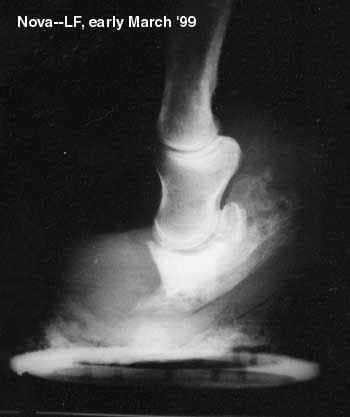
What the above foot looked like on the inside.
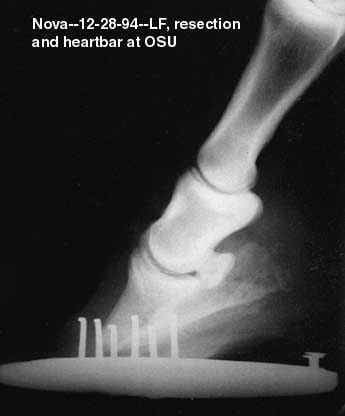
Compare the 12-94 x-ray with the 3-99 x-ray
to see how much he had deteriorated
despite 5 years of therapeutic shoeing.
A series of events conspired to prevent him from getting reset for some time. Do not blame Denise for how he looked in the photo above! The vets and farriers were reluctant to act, as no one was really sure what to do with him, bad as he was. This resulted in delays trimming and/or resetting him. Sabine advised against me trimming him, as the increased circulation that would result, if someone trimmed him correctly, might make him too sore to travel to Canada. There were further delays getting international health papers, and getting him on a truck to Canada. In Idaho, he was put off the truck because he was dehydrating; he was at a vet clinic for several days recovering, and then waiting for another truck to take him to Sabine's. He was in transit 3 weeks from Ohio to Canada, all told.
Nova is an excellent illustration of how allowing the coffin bone to point straight down towards the sole and ground plane will make it deteriorate over time--a good reason to keep the heels low!
This X-ray, taken after Sabine Kells dramatically lowered his heels, shows coffin bone deterioration. Although lowering his heels put the coffin bone in a more correct relationship to the ground plane, the damage from long-term high heels shows up in the tip of the coffin bone:
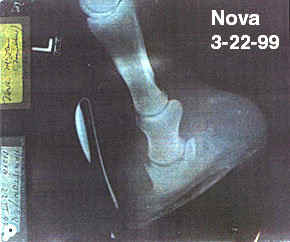
Sabine's first step trimming Nova--removing the shoe:
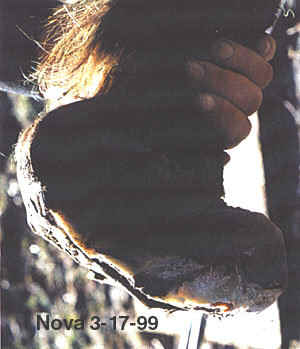
How he looked after his toes were backed up as well:
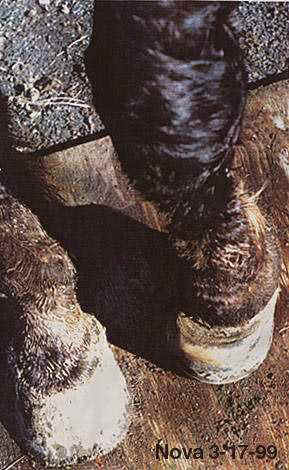
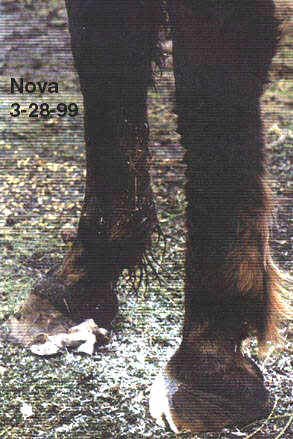
Correctly balancing his left foot dramatically straightened his "hopelessly" twisted left leg as well...see the "Before" photo on left.
Further, note how his contracted heels spread 1/2" in just 11 days:
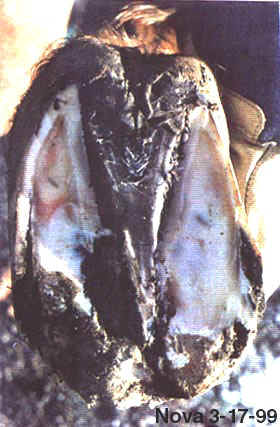
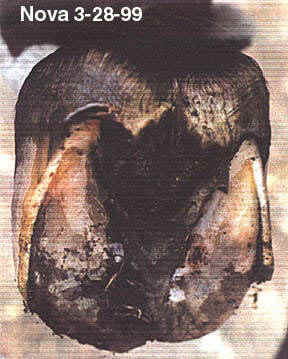
DO NOT TRY THIS without first studying the Strasser method at one of their hoof clinics...AND getting additional training! Undertaking such a severe case is not for beginners!
I provide this case study to illustrate the principles of correcting founder--using the worst imaginable case--to show the benefits of lowering the heels and backing up the toes.
Some of the possible areas where you can get into trouble with this--the horse can get very sore from a realignment of the bones and changing pulls on tendons. However, the main source of increased soreness is the sudden increase in circulation--and resultant increase of feeling--that restoring hoof function can entail in the beginning. Allowing a sudden increase in circulation without keeping the horse moving enough to send the blood back up the legs can actually cause trouble as the increased blood flow stays pooled in the feet from inactivity. A vital part of Nova's therapy is activity. He was hand walked 4 miles a day even at his worst, and kept outdoors in the company of a herd 24 hours a day to keep him moving. As he gets better, he will get even more daily miles put on him. It is important that he be hand walked on non-concussive ground in the earlier stages when the laminitic bond is still weak, and not trotted or cantered, or walked on concussive ground without removable hoof boots to absorb concussion.
Do not attempt the Strasser method if you cannot follow it 100%. Doing a Strasser trim, which greatly increases blood flow into the feet, and then keeping the horse stall-bound, can result in extreme inflammation, which can result in more rotation, and even lead to shock. Keeping the horse moving, and never confined to a stall, even overnight, is key to this method working. If you cannot provide 24 hour freedom of movement, or are not willing to follow the method all the way, I do not recommend it to you.
Restoring hoof function entails getting all those moving parts moving again by increasing flexibility. The heels expand with each step, and the sole draws flat with each step. Many shoeing variations prevent or reduce this movement. Although this movement is necessary to allow optimum circulation, it also allows further rotation in the initial stages of recovery. To quote Sabine Kells, in a letter to me:
| "Yes, this trim often does result in "rotation" if there is already damage inside the foot. It makes the foot flexible, and often a coffin bone in a hoof with a lot of damage is held up only through a thick sole (or shoe) or anything else that makes it inflexible. Once normal flexibility is restored, the sole draws flat on weightbearing and the coffin bone often just "follows it down" since the white line is too damaged to support it. But this is a temporary situation, and since the hoof can function properly [again], it begins to repair itself, and rotation usually disappears within about 4 months." |
Click here for rough, tentative sketches of how I trim foundered horses
(432K. Download times: 28.8K: 2.6 min.--56K: 1.7 min.--T1--4.1 sec.)
Nova update--he went from being 3-legged lame on arrival to walking so fast that he was too fast for his handlers to keep up with him, and too fast for the horses they ponied him off of. A month into his therapy, they rode him lightly on soft ground a couple of times...a real milestone! However, he is still not 100% rideable. He has also had some abscessing periods. The general trend has been upward, however, and his hooves are continuing to show structural improvements. He has been cantering more out in the herd lately as well.
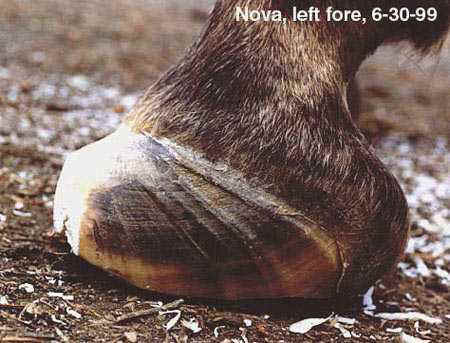
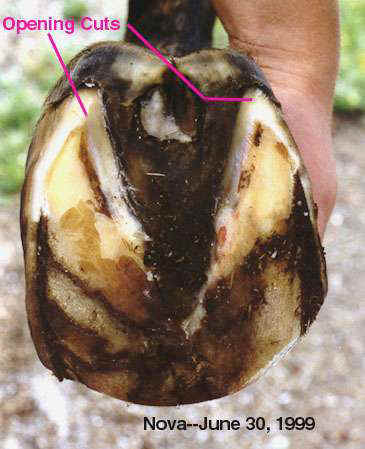
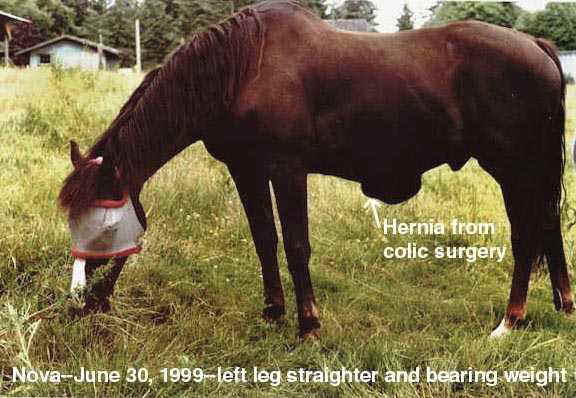
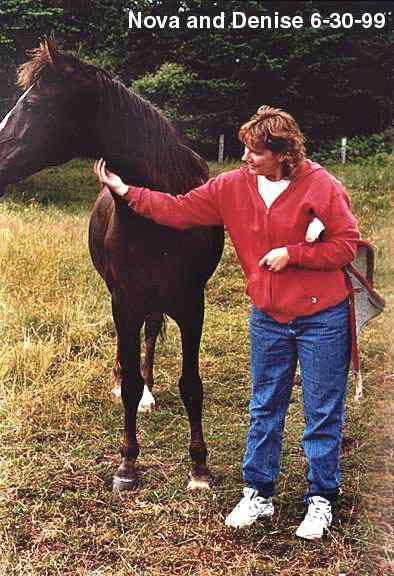
As I get more photos in the future of Nova's progress, I will add them to this page.
My thanks to Sabine Kells for the use of the photos of Nova taken in March of 1999, and to Denise McLain for her permission to publish Nova's story.
I am extremely sad to report that Nova died March 14, 2001; he had colic so severe that there was no choice, but to put him down--they were afraid he would not even survive the trip to the hospital. He had had severe colic in May of 2000, and had colic surgery at that time, with some complications. I visited him and Denise not too long before his last colic, and he seemed bright and happy. He was a brave horse, whose story helped so many other horses, and he could not have had a more loving and loyal owner. When I last saw him he walking better than I had seen him in the past. It was a sad day for us all.
Denise McLain, Nova's owner, may be contacted at dmclain@core.com Denise was so inspired by the progress she did see in Nova using barefoot methods that she became a professional trimmer. She really is a healer at heart, and enjoys seeing the cases she is working on improve.
As much coffin bone loss as Nova had, you cannot realistically have expected a full return to soundness. The hoof is similar to one of our fingers; the hoof wall is equivalent to one of our finger nails. The coffin bone is suspended inside the hoof capsule via a laminar connection. When the bone is half gone, and the front surface greatly pitted and roughened up by bone loss, you cannot expect as strong a connection to grow down and re-suspend the coffin bone. A full return to soundness in a case with this much bone loss is an unrealistic thing to expect. However, correcting hoof form can offer the horse enough relief that he can go on, and correcting hoof form will help halt the progression of further coffin bone loss.
Back to home page--Table of Contents
Article in sections with "thumbnail" photos for fastest downloads:
1 9 17
2 10 18
3 11 19
4 12 20
5 13 21
6 14 22
7 15 23
8 16 24
NAVICULAR
Article in sections with full-sized photos for print-outs:
1 9 17
2 10 18
3 11 19
4 12 20
5 13 21
6 14 22
7 15 23
8 16 24
NAVICULAR
To Strasser case studies--thumbnail photos for faster downloads
To Strasser case studies--large photos
Please sign my guest book! Photos of my pets My farm
Share Barefoot success stories on this page
Buy or sell used HORSE BOOTS Natural board Barn Listings
Click here to subscribe to naturalhorsetrim
(I strictly moderate this listserv to weed out "fluff.")
Send Email to Gretchen Fathauer, or call (740) 674-4492
Copyright by Gretchen Fathauer, 2015. All rights reserved.